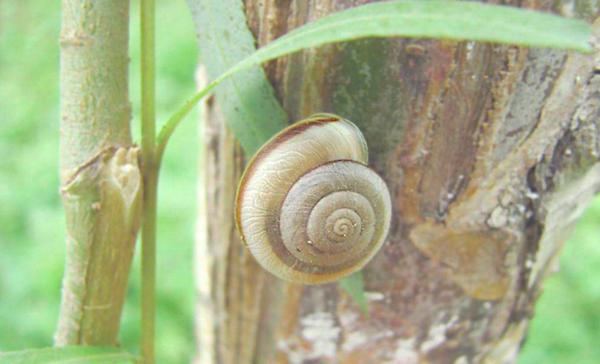Snails can be seen everywhere in the countryside, on walls, in the fields, in orchards, etc. Especially after the rain on cloudy days, snails are particularly active, and the shady surface of the outer wall of the home is the traces left by snails crawling. From childhood contact is not unfamiliar with snails, and there is a popular riddle about snails, "Say it is a cow, but it will not pull the plow, laugh at its small strength, and run on its back to the house." When it is sunny, the snail will shrink into the shell, leaving a thin paper-like film at the mouth of the shell, and when it is a child, it will be pricked with grass, and the snail will appear in a moment.
Common in the countryside of the hometown is a white shell snail, called the strip snail. It is small, usually no more than a centimeter in diameter, and has a brown mark on the shell. Perhaps as a farmer, I didn't have much of a good feeling for snails, and the vegetables I planted in the yard were nibbled. But in the lonely childhood, snails are also good playmates, often collecting snails they see and using them to feed ducks and chickens after playing.

I don't know when there was more than one snail outside the village, with a brown shell throughout and much larger size. At that time, I asked many adults, but I couldn't say what it was called, and I didn't have much impression. Because it is relatively rare, I have also deliberately picked up a few animals to breed. In recent years, it has been found that the number of such snails has increased, and it can be found in just a few steps. Perhaps because of the lack of natural enemies, there is a tendency to spread, becoming a common pest in the field.
This snail has been plagued in many places, especially in corn fields. The corn leaves were all nibbled away, and they climbed in along the corn whiskers to eat the corn. In serious places, there can be dozens of corn trees, and those who do not know it think that it is specially farmed. Although the insecticide has a certain effect, it is not obvious, and many villagers can only catch insects by hand and pick up a bucket when they are young.
I have consulted some information about this snail, which is called "gray snail" and is distributed everywhere. Prefers to lurk in shaded and damp places, day and night out, and prefers to eat in the evening and early morning. If it encounters high temperature and dry conditions, the mouth will be closed, lurking in the wet soil cracks or under the leaves, and other suitable conditions will come out again. The fields are ideal for breeding this snail, with moist land and sun obscured and adequate rations.
Snails reproduce faster because they are hermaphrodites, and any two snails can reproduce offspring. Each snail can lay eggs 6-7 times a year and hatch about eight days after spawning. And snail reproduction is not limited by age, the larger the snail lays more eggs. Now in the countryside, the number of snails is increasing because of the reduction of some wild animals such as various birds, lizards, toads, hedgehogs, fireflies and other animals.
For the prevention of snails, the main thing is to spray medicine, and in serious places, artificial capture will be adopted, and some chickens and ducks can be stocked in conditional farmland. It is a pity that there is no habit of eating snails in China, otherwise it does not matter even in the flood, sooner or later it will be eaten clean.